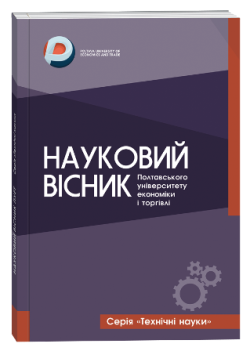DEVELOPMENT OF A WASTE-FREE TECHNOLOGY FOR OBTAINING NATURAL DYES FROM PLANT RAW MATERIALS
Abstract
Dyes are widely used in the food industry for the production of a variety of food products. As a general rule, manufacturers prefer artificial food colors that are more stable during heat treatment and storage. At the same time, consumers prefer natural dyes that are safe for the human body. In the modern world, the requirements for the quality and safety of additives are constantly increasing. Multifunctionality is an important indicator that determines the choice of the consumer. The purpose of this study is to develop a waste-free technology for obtaining natural food dyes, anthocyanins and betacyanin, from plant materials. The object of research is the technology of processing plant raw materials by the method of osmotic dehydration. Affordable raw materials were chosen as the subject of the study: red beet (Beta vulgaris) and black elderberry (Sambucus nigra). This raw material is not only a source of coloring substances (anthocyanins and beta cyanine), but also contains vitamins, dietary fiber, antioxidants, amino acids, and minerals. The proposed processing mode allows you to save the biological value of beets and elderberries. According to the developed technological scheme, a liquid dye is produced based on an osmotic solution and a powder dye, made from the main part of the raw material. Thus, the resource potential of raw materials is used in full. The physicochemical properties of liquid dyes (mass fraction of sucrose and solids) are analyzed. The high content of sucrose in dyes makes them an attractive raw material for the production of many food products. The SWOT analysis method identified the strengths and weaknesses of this technology, the prospects and difficulties associated with the introduction of this technology into production. It has been established that the developed technology has a number of advantages, including: the availability of raw materials, environmental friendliness, a shorter overall process time, the highest biological value of dyes, their multifunctionality, and the versatility of the technology.
References
2. Переверткина И.В., Волков А.Д., Титова Н.Н., Болотов В.М. Оптимизация условий экстрагирования антоціанових красителей из растительного сырья. Химия растительного сырья. 2014. № 2. С 137–141.
3. Назарко І. Безпечність використання харчових барвників. Матеріали XVІI наукової конференції ТНТУ ім. І. Пулюя. 2013. Том І. Природничі науки та інформаційні технології. С.75.
4. Папченко В.Ю., Кузнецова Л.М. Узагальнення наукових основ одержання харчових барвників. Вісник НТУ «ХПІ». 2015. № 44 (1153). С. 65–68.
5. Elbe J.H.V., Betalains R.E., Wrolstad T.E., Acree H. An, Decker E.A., Penner M.H., Reid D.S., Schwartz S.J., Shoemaker C.F., Sporns P. Current protocols in food analytical chemistry. John Wiley and Sons Inc. 2001. pp. F3.1.1–F3.1.7.
6. Eloá Lourenço do Carmo, Rhana Amanda Ribeiro Teodoro, Pedro Henrique Campelo Félix, Regiane Victória de Barros Fernandes, Érica Resende de Oliveira,Taís Regina Lima Abreu Veiga, Soraia Vilela Borges, Diego Alvarenga Botrel Stability of spray-dried beetroot extract using oligosaccharides and whey proteins. Food Chemistry. 2018. № 249. Р. 51–59. DOI: https://doi.org/10.1016/j.foodchem.2017.12.076
7. Vergara C., Saavedra J., Sáenz C., García P., Robert P. Microencapsulation of pulp and ultrafiltered cactus pear (Opuntia ficus-indica) extracts and betanin stability during storage. Food Chemistry. 2014. № 157. P. 246–251.
8. Бурак Л. Перспективи використання бузини чорної в харчовій промисловості. Продовольча індустрія АПК. 2012. № 4 (18). С. 31–33.
9. Коберник І., Стеценко Н. Обґрунтування доцільності використання ягід бузини чорної для виробництва натурального барвника. Оздоровчі харчові продукти та дієтичні добавки: технології, якість та безпека : матеріали Міжнародної науково-практичної конференції, (14–15 листопада 2019 р., м. Київ). 2019. С. 41–43.
10. Janiszewska E. Microencapsulated beetroot juice as a potential source of betalain. Powder Technology. 2014. № 264. P.190–196.
11. Perevertkina I. V., Volkov A. D., Bolotov V. M. Vliyanie golicerina na ehkstragirovanie antocianovyh pigmentov iz rastitel’nogo syr’ya. Himiya rastitel’nogo sir’ya. 2011. No. 2. P. 187–188.
12. Savvin P. N., Bolotov V. M. Issledovanie antioksidantnyh svoistv zheleinogo marmelada. Himiya rastitelnogo syrya. 2008. No. 4. P. 177–179.
13. Ковалевський К.А., Мамай О.І, Валько М.І., Шанін О.Д., Кузьміна Т.О. Технологія виробництва натуральних харчових барвників. Вісник ХНТУ. 2017. № 2(61). С.155–159.
14. Квасніков А.А. Натуральні барвники з кизилу і терену дикорослих для варених ковбасних виробів. Науковий вісник Полтавського університету економіки і торгівлі. 2010. № 1(46). С.79–83.
15. Yadav A.K., Singh S.V. Osmotic dehydration of fruits and vegetables: a review. Food Sci Technol. 2014. № 51 (9). Р. 1654–1673.
16. Khan M.R. Osmotic dehydration technique for fruits preservation – A review. Pakistan Journal of Food Sciences. 2012. № 22(2). Р. 71–85.
17. Charles T., John O., Anthony B. Multilinear Regression Approach in Predicting Osmo-Dehydration Processes of Apple, Banana and Potato. Food Process Technol. 2011. № 2. Р. 1–6.
18. Samilyk M., Helikh А., Bolgova N., Potapov V., Sabadash S. The application of osmotic dehydration in the technology of producing candied root vegetables. Eastern-European Journal of Enterprise Technologies. 2020. № 3(11). С. 13–20.
19. Samilyk M, Bolgova N, Tsyrulyk R, Ryzhkova T. Prospects for processing and use of root vegetable waste in food production. Food science and technology. 2021. № 15(4). Р. 60–68. DOI: https:// 10.15673/fst.v15i4.2253.
20. Papchenko V., Matveeva T., Belinska A., Rudniev V., Zviahintseva O., Cherevichna N. Investigation of anthoicians availability in sunflower seed husks. Technology Audit and Production Reserves. 2017. № 4(3(36). Р. 31–34. DOI: https://doi.org/10.15587/2312-8372.2017.108369.


